Sea Ray Founder Dies at 84
Cornelius Nathaniel "Connie" Ray III, founder of Sea Ray Boats, died Nov. 12 after a five-year battle with cancer. He was 84 years old. Ray founded Sea Ray in 1959 in Oxford, Mich., and built it into the world's largest boat company at the time with 40 models from 17 feet to 60 feet. He sold the company in December 1986 to Brunswick Corp. for $350 million dollars. At the time the company had 4,500 employees and built 28,000 boats a year.
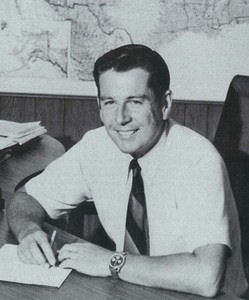 C.N. “Connie” Ray sold Sea Ray Boats to Brunswick in 1986 for $350 million and retired four years later at 65. He always was a man with a plan. |
When we first met C.N. Ray we were struck by his quiet charisma, incisive mind and his ability to cut quickly to the chase in nearly any discussion. He was decisive, and always seemed to have a plan. From our perspective the foundation of Sea Ray’s success in the first 25 years of its existence wasn’t its boats so much as it was the force of C.N.’s personality and his understanding of what was truly important in building a leading brand with high unit sales.
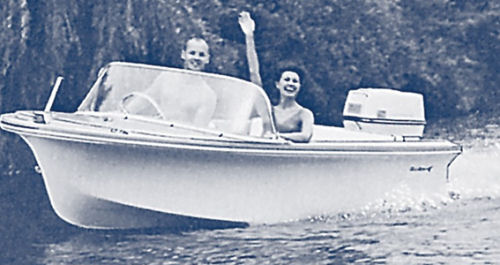 A vintage 1961 Sea Ray. The company got off to a fast start. Look carefully and you’ll still see a few of these models around today. |
A Pioneer in Fiberglass
One of the early builders in fiberglass, Ray started out manufacturing a 16-foot family runabout in a small shop he had bought in 1959 that had also fabricated golf cart bodies and coffins. Focusing on building boats, he turned to the Detroit automakers as models for merchandising. He introduced high styling (relatively speaking), brought a GM designer to the plant to help style his boats' interiors - the consoles and upholstery - like car interiors.
"We were already setting ourselves apart from our competition with strict attention to the basics: superior products, superior dealers and a sincere appreciation of our customers," C.N. once wrote of his company in its very first year in business.
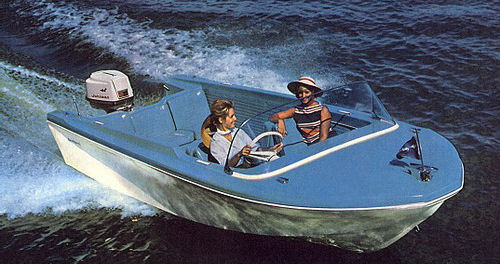 A 1963 Sea Ray. |
Built on A Strong Dealer Network
Because Ray grew up in Detroit and went to school at Detroit University in Grosse Pointe, MI, he knew how General Motors had quickly become the sales and profit leader of the Big Three in the 1920s. While there are a number of reasons, one of the most important was the fact that top GM executives went around the country and identified the best capitalized, best located and best run dealerships that existed at the dawn of the automobile era. Alfred P. Sloan’s vision for the future of GM and its dealers was sold to – and embraced by – the best dealers in the country. GM stayed on top for 50 years because of its dealers.
Only the Best Dealers
"He believed that distribution was king, that you built a good-quality boat, backed it up, delivered good customer service, and got the best dealers," said Robert J. Parmentier, Sea Ray's current president and an employee of Ray's in the early 1980s.
Most veteran industry observers know that the bedrock of Sea Ray’s success was the incredibly powerful dealer network Ray set up around the country. Like most boat builders starting out in the 1960s, he personally sold dealers on becoming a Sea Ray dealer. But he didn’t want just any dealer. Like GM he wanted only the best, and if couldn’t get a good dealer in a territory, he took a pass.
Typically, Ray would investigate a market area, find out who were the best dealers, get to know them, then select one who had a combination of strong capitalization and marketing savvy. In places where he could not find a properly capitalized dealer, but could find a good marketer, we’re told that he would co-sign a note to get the dealer off the ground and running.
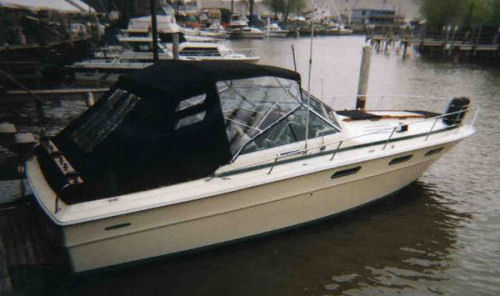 A 1974 Sea Ray 300 Weekender is still going strong. |
Come Fly With Me
C.N. Ray was a WW II pilot and used his flying ability to his advantage when wooing dealers he wanted who were playing hard-to-get. By flying in to pick them up, then whisking them off to another location for lunch or dinner he got their attention and usually their dealership. Back in the 1960’s and ‘70s Ray was just about the only boat company president doing that. Even the most successful boat dealers were not so rich or jaded that they couldn’t have their head turned with a ride in Ray’s Lear Jet.
At 35,000 feet C.N. painted a rosy picture of the future and told them that he would make them millionaires. And many Sea Ray dealers did make millions in the heady go-go sales years of the mid-1980s and afterward. Eventually many of those dealers banded together and created MarineMax, the public company, that made them even richer and proved to be a fine exit strategy for many.
Ray was also tough and had high expectations of all of his dealerships. Stories are still told about dealers who he personally liked, but who were no longer running their business as Ray expected, and who lost their franchises as a result after fair warning.
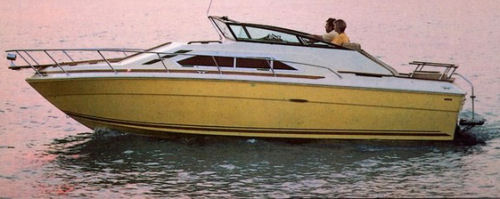 A 1980 Sea Ray express cruiser. |
Courting the Customer
Ray also was a strong believer in customer service and customer satisfaction and was far ahead of the rest of industry in this regard. Long before J.D. Power & Associates started mining this mother lode with expensive surveys sold to boat builders, Ray was personally calling his owners and finding out first hand what they liked and didn’t like about his boats. We have been told by his associates over the years that he would ask for a stack of warranty cards and call his owners by model or by sales territory, making notes and solving problems as he went, and building brand loyalty one at a time.
We have also been told that C.N. Ray had a rule that any employee answering the phone from a customer who had a problem was responsible for putting the matter to rights. Passing the buck wasn’t allowed, nor was not taking phone calls from owners. We are told that if C.N. found out that an employee hadn’t solved a customer’s problem satisfactorily, there would be hell to pay. In this way he had everyone in the executive suite as an ad hoc customer service representative. Of course it wasn’t organized, nor out of a MBA’s text book, but evidently it worked and built customer loyalty over the years.
The New Boat Buyer
In the 1960s and 1970s Sea Ray boats were not known for being great performers, but they always looked good, had lots of room, and they were easy-to-drive powerboats which appealed to many affluent baby boomers. And better yet, the Sea Ray dealers were very friendly. Sea Ray dealers were not a bit bothered that these new prospects didn’t know the difference between a bowline and a bowtie. They had the money and Sea Ray had the boats.
Many of the Sea Ray buyers were first time buyers and for them, most of what they knew about boating they had learned from their Sea Ray dealers. In the early 1970s some dealers of traditional, more “pedigreed” motorboats (which were often built of genuine tree wood) would not take a Sea Ray in trade, and of course Sea Ray management couldn’t have been happier.
America’s Powerboat Style Leader
It is hard for many current boaters to remember it, but back in the 1970s many “cabin cruisers” and express boats were still very much out of the 1950s, which is to say, boxy and squared off. Sea Rays were the exception and C.N. was usually the industry leader in the direction of what we would call today, more European styling. Sea Rays were the first express cruisers with oval port lights and more sculptured topsides.
As Sea Ray became a sales leader other builders began looking to the Sea Ray new model introductions to see exactly how European, or “different” their designs could be. Then in 1980 Trojan (which built some of the most traditional-looking powerboats) blew far past Sea Ray in terms of both interior and exterior Euro-styling. The Trojan 10 Metre and other larger boats in their Meter Series set the design pace until the 10% luxury tax brought Trojan to its knees in the early 1990s. But by that time, C.N. had retired at age 65 in 1990.
The Popular Sundancer
Sea Ray was the company responsible for popularizing the express cruiser concept with its Sundancer seried. That all started in the 1970s when C.N. and Sea Ray were on a fantastic roll. He and his design team worked hard to make the ‘dancers bigger inside and sleeker outside. To a great degree C.N. and his staff in the ‘70s evolved the American powerboat buyer away from cabin cruisers, convertibles and sedans and into what we call today the modern express cruiser. C.N. Ray was a visionary, and he pushed the styling envelope, but he was also careful not to get too far ahead of the American boat buyer’s nautical aesthetic eye.
Today the great majority of American express cruisers look as they do because of C.N. Ray who set the course many years ago.
Sea Ray President
Parmentier describes Ray as one of the industry's icons. "He helped develop the fiberglass boat business," Parmentier said. "He was always a step ahead of his time."
Life After Sea Ray
A talented man in many directions, ‘Connie’ also had an extreme fondness for thoroughbred horses and in 1983 acquired the 400-acre ‘Evergreen Farms’, in Kentucky, a noted thoroughbred breeding facility. ‘Connie’ was to enjoy as much success with his horses as he did with his boats.
His horses won a number of renowned Breeder Cups, one of them, ‘Lit de Justice’ also triumphing in the Eclipse Award, a prestigious honour sponsored by the National Thoroughbred Racing Association and the National Turf Writers Association.
‘Connie’ raced 14 other stakes winners, among his victories such well-known events as Arlington Million, San Juan Capistrano Handicap, the Eddie Read Handicap and the Shoemaker Breeder’s Cup.
Born May 14, 1925, to Charles H. Ray and Virginia Bryant Ray in Detroit, Ray attended the Detroit University School in Grosse Pointe, Mich., joined the Army Air Corps during World War II and graduated from UCLA in 1949. Known to his friends as C.N. or "Connie," Ray was "passionate about enjoying life, boating, aviation, and animals, especially thoroughbred horses," said his son, C.C. Ray.
Ray is survived by a daughter, five sons and his wife of 28 years, Carol. His sister, Trudy, and a sixth son, Cornel, predeceased him.
We would appreciate hearing from friends, former employees, customers and dealers who have C.N. Ray tributes or stories, or even old pictures that they would like to share. We will put these in a permanent archive --